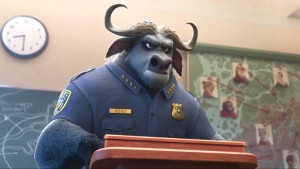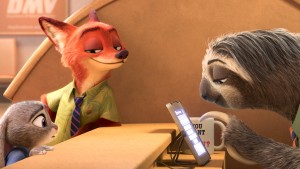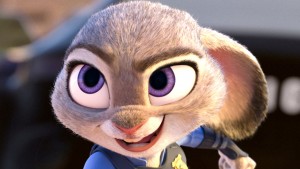By Cleaver Patterson.
Judy Hopps (Ginnifer Goodwin) is a young bunny with big ideas. Living in the rural town of Bunnyburrow her parents expect her to follow in the family tradition, growing and selling various fruit and vegetables. But Judy yearns to go to the fabled city of Zootopia, where she aims to become the first rabbit to join the city’s police department. Despite her parent’s misgivings she’s accepted into the police training academy and graduates to become a fully fledged member of the police force. However as usual dreams bare little resemblance to reality, and she meets with hostility not just from the general public, but also the chauvinistic members of the mainly male police force itself. However, it’s not until she meets Nick Wilde (Jason Bateman), a wily and sly con-artist fox, that she realises her troubles are only beginning.
 It’s a fact universally acknowledged that, in the field of the animation, Disney reigns supreme. Save the occasional slip — Fantasia (1940), their exquisite blending of animation and classical music, now considered a masterpiece, bombed with critics and public alike when first released — almost every cartoon feature the house of mouse has turned out has turned to box-office gold. Their films — whether in the craftsmanship of their animation, credibility of their characters or inventiveness of their stories — released over the last seventy plus years have set the standard by which other studios have tried, though more often than not failed, to emulate.
It’s a fact universally acknowledged that, in the field of the animation, Disney reigns supreme. Save the occasional slip — Fantasia (1940), their exquisite blending of animation and classical music, now considered a masterpiece, bombed with critics and public alike when first released — almost every cartoon feature the house of mouse has turned out has turned to box-office gold. Their films — whether in the craftsmanship of their animation, credibility of their characters or inventiveness of their stories — released over the last seventy plus years have set the standard by which other studios have tried, though more often than not failed, to emulate.
The studio’s success seemingly came to a head with Frozen (2013) which became the most successful animated feature ever grossing over $1,250,000,000 at the box-office. Until, that is, their new smash-hit Zootopia (2016) (aka Zootropolis in some countries, including the UK) — directed by Byron Howard and Rich Moore and featuring the voice talents of Goodwin, Bateman and Idris Elba — opened with estimated takings during its first weekend of $70,000,000 plus in America, putting even Frozen’s American three day opening record of $67,000,000 in the shade. What, you ask, could make a hundred and eight minute cartoon, so popular? Is there really anywhere else that this art form can go? Well, in this age of computer generated animation where you can see every hair on an animal’s body twitch and every individual blade of grass in a field move with the slightest breath of wind, perhaps not in the visual department. Instead these films have begun refocusing their energies on clever plots and characterisation, elements which have always had a strong appeal in Disney’s films.
 Of course Disney isn’t stupid and the bottom line, even with them, is to make money. If the filmmakers can come up with characters with public appeal which can be transformed into an endless string of merchandising opportunities, it creates a virtual licence to print money. Frozen did this, as well as winning an Oscar for its catchy theme song ‘Let It Go’, and you can see the same happening with Zootopia: expect very soon to see thousands of kids running round dressed like mini Officer Hops or in younger versions of Nick Wilde’s cool dude duds.
Of course Disney isn’t stupid and the bottom line, even with them, is to make money. If the filmmakers can come up with characters with public appeal which can be transformed into an endless string of merchandising opportunities, it creates a virtual licence to print money. Frozen did this, as well as winning an Oscar for its catchy theme song ‘Let It Go’, and you can see the same happening with Zootopia: expect very soon to see thousands of kids running round dressed like mini Officer Hops or in younger versions of Nick Wilde’s cool dude duds.
However, putting aside any cynicism about the crass commerciality of this ‘family’ orientated film, it so happens that Zootopia is also very ‘good’ entertainment, due in no small way to a wonderfully witty screenplay by Jared Bush and Phil Johnston. From the marvellously realised city of Zootopia where a virtual Noah’s Ark of animals going about their everyday business in perfect harmony, to the characters so brilliantly realised that the viewer forgets that these are not humans, but instead animals dressed and talking as them, the filmmakers have created a dry and sharply witty take on contemporary culture and modern morals. As usual with the most successful of these kind of films, there are enough ‘jokes’ and ‘inferences’ — many of which will go straight over kid’s heads — to keep adult viewers from getting bored. This, of course, is another ploy which Disney twigged onto early on and have used to their advantage ever since. Most kids will only see the film in the cinema if an adult accompanies them, so it’s to the studio’s advantage to include enough elements to keep the older market happy as well: here a running Godfather (1972) gag and subtle references to Private Benjamin (1980) will have those of a certain age doubled up with laughter.
 The other aspect which has always featured heavily in family animation — particularly in films originating from America — is the presence of a strong moral code. Here we have a message of non-conformity and the power of self-belief, as seen in Hopps determination to follow her dream and, against the odds, become Zootopias’ first rabbit police officer. This essence of the ultimate reward in individuality, is mirrored in the cavalcade of animal characters living side by side in harmony in a city which caters to every one of their distinct characteristics and idiosyncratic requirements.
The other aspect which has always featured heavily in family animation — particularly in films originating from America — is the presence of a strong moral code. Here we have a message of non-conformity and the power of self-belief, as seen in Hopps determination to follow her dream and, against the odds, become Zootopias’ first rabbit police officer. This essence of the ultimate reward in individuality, is mirrored in the cavalcade of animal characters living side by side in harmony in a city which caters to every one of their distinct characteristics and idiosyncratic requirements.
Ultimately the story behind Zootopia, like those which have formed the basis for many of Disney’s cartoon features, is a fairy tale, albeit this time a modern interpretation of one. Taken too seriously and impressionable children could be in danger of thinking that everything in real life will work out fine, like it does in the movies. On-the-other-hand a little more of Zootopia’s ‘fantasy’ in our lives, might not be such a bad thing either.
Cleaver Patterson is a film journalist and critic based in London. News Editor for Flickfeast website, he contributes to a number of other publications and websites including Rue Morgue, Film International and Video Watchdog.
Zootopia opened theatrically in the U.S. on the 4th March, 2015, and will open in the U.K. on the 25th March, 2015.

